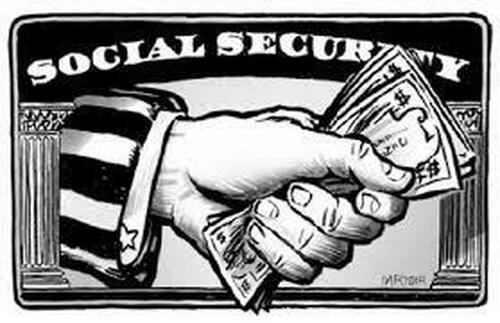
Submitted by Brenton Smith,
Back in August, former President Donald Trump issued a proclamation to voters on Truth Social, “seniors should not pay tax on social security!”
In layman terms, the statement from Trump implies that current retirees should get to keep more money at the expense of future retirees who would receive more painful reductions to benefits in eight years rather than nine.
While that trade-off may or may not appeal to voters in November, the taxation of Social Security benefits needs to be discussed before voters reach the polls in the coming election.
These rules date back 30 years, and Congress hasn't monitored the rules as closely as it should.
On one hand, the taxation of benefits is a vital source of revenue for Social Security. It will generate nearly $60 billion in revenue this year for Social Security, which approximates the contribution of nearly nine million workers who will never collect benefits. Moreover, that revenue is projected to double over the next 10 years.
At the same time, we can’t justify a tax simply because the revenue is important.
For a bit of background, the taxation of benefits was added in 1983 as a compromise to generate income that would be needed to pay benefits far in the future. The policy option accounted for about 33 percent of the total effectiveness of the legislative package, which stabilized the program's projected finances from 2030 through 2057.
Four decades later, the tax reaches an ever-increasing number of people for two reasons.
-
First, the threshold that triggers the levy is not adjusted for inflation, so the definition of “substantial outside income” falls in real terms every year.
-
Separately, the components of “outside income” are rising faster than inflation, particularly wages paid to people who are working during retirement.
As a consequence of these factors, more than 50 percent of beneficiaries who file taxes pay a levy on some portion of their benefits. An average worker in the United States working 30 hours per week, would generally expose his or her benefits to a marginal tax rate of more than 40 percent.
People wonder why the government taxes 85 percent of the check. In 1983, Congress required seniors to pay a tax on 50 percent of their benefits, but the portion was increased to 85 percent in 1993. Supporters of the change justified the increase based on research from the Social Security Administration actuarial team, which found that, even in a worst case scenario, someone collecting benefits today would make $0.85 cents of profit on every dollar received in the form of benefits.
Unfortunately for current retirees, no one knows whether the math done in the late 1980s has worked out for them as individuals.
At this point, the government collects an income tax from people who have to work in retirement to make ends meet at a marginal tax rate that is normally reserved for someone like Warren Buffett, when no one really knows whether the money is income or not. No one has bothered to check.
The one thing that we do know is that the trustees of the program expect seniors to pay an extra 8 to 9 billion dollars annually in taxes based on the expiration of the Tax Cut and Jobs Act in 2026.
So, there is a good chance that this unpopular tax will become even more unpopular.
This tax is vital to Social Security, but no one is watching it. The levy has drifted year to year; decade to decade; generation to generation without a lot of thought about who it affects or why it is applied. The rationale in Washington is retirees should pay the tax this year because they paid it last year.
Before anyone repeals the tax, Congress needs to figure out whether there is any profit in the money received by seniors, and then lawmakers can talk about to whom the tax might apply.
Submitted by Brenton Smith,
Back in August, former President Donald Trump issued a proclamation to voters on Truth Social, “seniors should not pay tax on social security!”
In layman terms, the statement from Trump implies that current retirees should get to keep more money at the expense of future retirees who would receive more painful reductions to benefits in eight years rather than nine.
While that trade-off may or may not appeal to voters in November, the taxation of Social Security benefits needs to be discussed before voters reach the polls in the coming election.
These rules date back 30 years, and Congress hasn’t monitored the rules as closely as it should.
On one hand, the taxation of benefits is a vital source of revenue for Social Security. It will generate nearly $60 billion in revenue this year for Social Security, which approximates the contribution of nearly nine million workers who will never collect benefits. Moreover, that revenue is projected to double over the next 10 years.
At the same time, we can’t justify a tax simply because the revenue is important.
For a bit of background, the taxation of benefits was added in 1983 as a compromise to generate income that would be needed to pay benefits far in the future. The policy option accounted for about 33 percent of the total effectiveness of the legislative package, which stabilized the program’s projected finances from 2030 through 2057.
Four decades later, the tax reaches an ever-increasing number of people for two reasons.
-
First, the threshold that triggers the levy is not adjusted for inflation, so the definition of “substantial outside income” falls in real terms every year.
-
Separately, the components of “outside income” are rising faster than inflation, particularly wages paid to people who are working during retirement.
As a consequence of these factors, more than 50 percent of beneficiaries who file taxes pay a levy on some portion of their benefits. An average worker in the United States working 30 hours per week, would generally expose his or her benefits to a marginal tax rate of more than 40 percent.
People wonder why the government taxes 85 percent of the check. In 1983, Congress required seniors to pay a tax on 50 percent of their benefits, but the portion was increased to 85 percent in 1993. Supporters of the change justified the increase based on research from the Social Security Administration actuarial team, which found that, even in a worst case scenario, someone collecting benefits today would make $0.85 cents of profit on every dollar received in the form of benefits.
Unfortunately for current retirees, no one knows whether the math done in the late 1980s has worked out for them as individuals.
At this point, the government collects an income tax from people who have to work in retirement to make ends meet at a marginal tax rate that is normally reserved for someone like Warren Buffett, when no one really knows whether the money is income or not. No one has bothered to check.
The one thing that we do know is that the trustees of the program expect seniors to pay an extra 8 to 9 billion dollars annually in taxes based on the expiration of the Tax Cut and Jobs Act in 2026.
So, there is a good chance that this unpopular tax will become even more unpopular.
This tax is vital to Social Security, but no one is watching it. The levy has drifted year to year; decade to decade; generation to generation without a lot of thought about who it affects or why it is applied. The rationale in Washington is retirees should pay the tax this year because they paid it last year.
Before anyone repeals the tax, Congress needs to figure out whether there is any profit in the money received by seniors, and then lawmakers can talk about to whom the tax might apply.
Loading…




